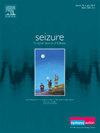Prediction begins with diagnosis: Estimating seizure recurrence risk in the First Seizure Clinic
IF 2.7
3区 医学
Q2 CLINICAL NEUROLOGY
引用次数: 0
Abstract
Objectives
To assess the feasibility of using a seizure recurrence prediction tool in a First Seizure Clinic, considering (1) the accuracy of initial clinical diagnoses and (2) performance of automated computational models in predicting seizure recurrence after first unprovoked seizure (FUS).
Methods
To assess diagnostic accuracy, we analysed all sustained and revised diagnoses in patients seen at a First Seizure Clinic over 5 years with 6+ months follow-up (‘accuracy cohort’, n = 487).
To estimate prediction of 12-month seizure recurrence after FUS, we used a logistic regression of clinical factors on a multicentre FUS cohort (‘prediction cohort’, n = 181), and compared performance to a recently published seizure recurrence model.
Results
Initial diagnosis was sustained over 6+ months follow-up in 69% of patients in the ‘accuracy cohort’. Misdiagnosis occurred in 5%, and determination of unclassified diagnosis in 9%. Progression to epilepsy occurred in 17%, either following FUS or initial acute symptomatic seizure.
Within the ‘prediction cohort’ with FUS, 12-month seizure recurrence rate was 41% (95% CI [33.8%, 48.5%]). Nocturnal seizure, focal seizure semiology and developmental disability were predictive factors. Our model yielded an Area under the Receiver Operating Characteristic curve (AUC) of 0.60 (95% CI [0.59, 0.64]).
Conclusions
High clinical accuracy can be achieved at the initial visit to a First Seizure Clinic. This shows that diagnosis will not limit the application of seizure recurrence prediction tools in this context. However, based on the modest performance of currently available seizure recurrence prediction tools using clinical factors, we conclude that data beyond clinical factors alone will be needed to improve predictive performance.
预测始于诊断:估算首次癫痫发作门诊的癫痫复发风险。
目的评估在癫痫首次发作门诊中使用癫痫复发预测工具的可行性,考虑(1)初步临床诊断的准确性和(2)自动计算模型在预测首次无诱因癫痫发作(FUS)后癫痫复发方面的性能:为了评估诊断的准确性,我们分析了在癫痫首次发作门诊就诊 5 年以上、随访 6 个月以上的患者的所有持续诊断和修订诊断("准确性队列",n = 487)。为了估计 FUS 术后 12 个月癫痫复发的预测率,我们对 FUS 多中心队列("预测队列",n = 181)的临床因素进行了逻辑回归,并与最近发表的癫痫复发模型进行了比较:结果:在 "准确性队列 "中,69%的患者在随访6个月以上后仍能得到初步诊断。5%的患者被误诊,9%的患者被确定为未分类诊断。17%的患者在FUS或最初的急性症状发作后发展为癫痫。在使用 FUS 的 "预测队列 "中,12 个月的癫痫复发率为 41%(95% CI [33.8%, 48.5%])。夜间发作、局灶性发作半身像和发育障碍是预测因素。我们的模型得出的接收者操作特征曲线下面积(AUC)为 0.60(95% CI [0.59,0.64]):结论:在首次癫痫发作门诊就诊时可获得较高的临床准确性。结论:首次癫痫发作门诊的首次就诊可达到较高的临床准确性,这表明诊断并不会限制癫痫发作复发预测工具在这种情况下的应用。然而,基于目前可用的使用临床因素的癫痫复发预测工具表现一般,我们得出结论:要提高预测性能,还需要临床因素以外的数据。
本文章由计算机程序翻译,如有差异,请以英文原文为准。
求助全文
约1分钟内获得全文
求助全文
来源期刊

Seizure-European Journal of Epilepsy
医学-临床神经学
CiteScore
5.60
自引率
6.70%
发文量
231
审稿时长
34 days
期刊介绍:
Seizure - European Journal of Epilepsy is an international journal owned by Epilepsy Action (the largest member led epilepsy organisation in the UK). It provides a forum for papers on all topics related to epilepsy and seizure disorders.
 求助内容:
求助内容: 应助结果提醒方式:
应助结果提醒方式:


